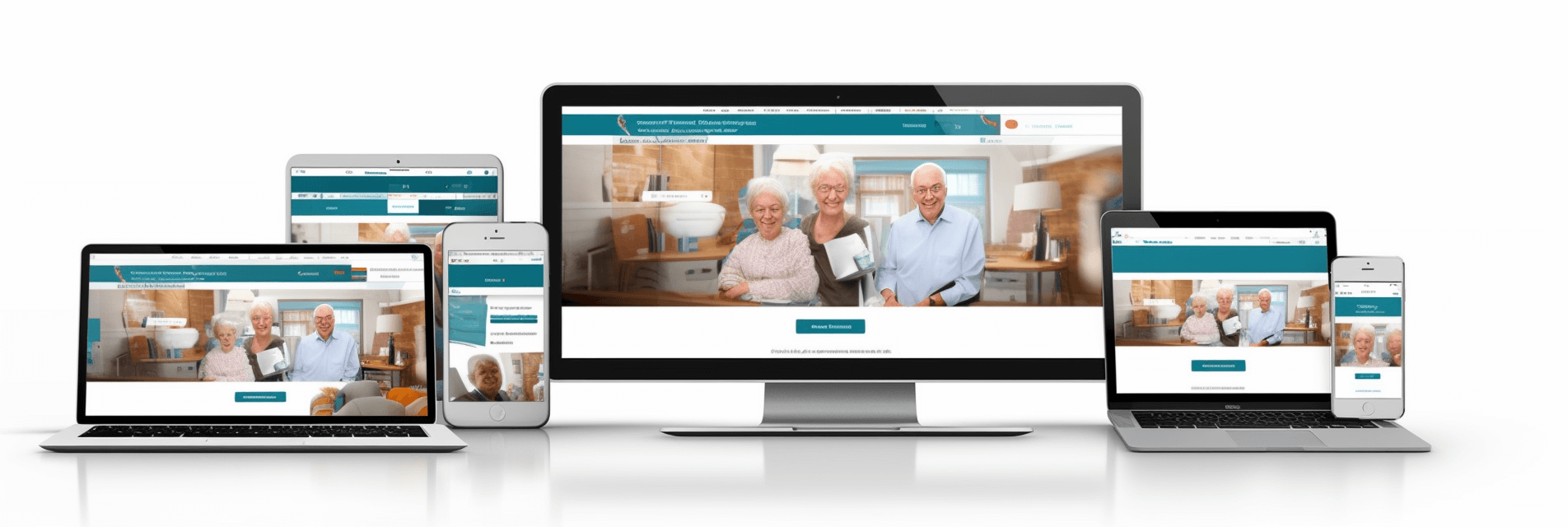As we embrace the beautiful diversity of Canada, we can’t help but notice the growing need for senior care services that cater to various cultural backgrounds and languages. With an increasingly aging population and many seniors coming from different parts of the world, it’s essential to ensure they have access to culturally sensitive resources available in their native language.
That’s where multilingual senior care websites come into play, solving this pressing issue and ensuring our elderly loved ones feel included in their golden years.
In this article, we will explore the benefits of such websites, discuss some challenges faced when creating them, highlight examples of existing multilingual senior care platforms in Canada, and look into future developments and opportunities within this niche market.
By fostering better communication between seniors and caregivers regardless of linguistic differences, these websites hold the key to more inclusive eldercare services across our nation – because everyone deserves to age gracefully with dignity and respect.
The Growing Need for Multilingual Senior Care Services in Canada

As our diverse population ages, there’s an increasing demand for elder care services that cater to various languages and cultures. Language barriers can make accessing essential healthcare and support services challenging for seniors who aren’t fluent in English or French.
With Canada’s diverse demographics, these needs must be addressed to create more inclusive communities where everyone feels like they belong. We can help bridge this gap by developing multilingual senior care websites tailored to the unique cultural requirements of different ethnic groups.
By offering relevant and easy-to-understand information in multiple languages, we can reach a broader audience and ensure all seniors can access essential resources without feeling left behind due to language differences. This approach also fosters a sense of belonging among seniors from various backgrounds, as they know their needs are being considered.
We believe that embracing the linguistic diversity of our aging population will lead us toward creating more inclusive healthcare systems that leave no one behind. Developing multilingual senior care websites is just one step towards achieving this goal; however, it holds tremendous potential in breaking down language barriers and ensuring equal access to vital information for all seniors regardless of their language proficiency.
Together, let’s build stronger connections within our multicultural society by supporting initiatives promoting inclusivity at every stage of life.
As we strive to create inclusive and accessible senior care solutions, one crucial aspect to consider is the availability of multilingual senior care websites.
By offering diverse language options, we can bridge communication barriers between seniors and their caregivers, leading to a better understanding of the services and more personalized care.
Additionally, this will allow family members who speak different languages to stay informed about their loved ones’ well-being and actively participate in their healthcare decisions.
Accessibility for Diverse Language Speakers
In today’s diverse society, ensuring language accessibility is essential for effectively catering to the needs of different communities. As we strive to create a more inclusive environment for everyone, our senior care websites must be designed with diverse representation in mind.
By offering multilingual options, we break down language barriers and ensure that seniors from various cultural backgrounds feel welcome and understood when seeking information and support. By providing accessibility for diverse language speakers, we empower individuals and foster a sense of belonging within the community.
This inclusivity allows seniors from all walks of life to confidently access necessary resources without feeling alienated or left out due to language limitations. This encourages their active participation in the community, contributing to their overall well-being and happiness.
Ultimately, prioritizing linguistic diversity on senior care websites creates an environment where everyone can thrive together — regardless of their native tongue.
Improved Communication with Care Providers

By enhancing communication between seniors and their care providers, we’re fostering understanding and promoting trust and collaboration. Effective communication is critical to ensuring that seniors receive the care they need, particularly when language barriers could otherwise hinder the process.
By offering multilingual senior care websites in Canada, we empower seniors and their caregivers to easily navigate important information about services available, helping them make informed decisions together. Creating an inclusive environment where everyone feels welcome and understood is crucial for building strong relationships within our diverse communities.
Multilingual senior care websites encourage a sense of belonging by acknowledging the varying linguistic backgrounds of Canada’s aging population. They help bridge gaps in understanding while fostering a greater sense of connection between those who require assistance and the professionals providing it.
In turn, this creates a more supportive environment for all involved – one where everyone can thrive as they work together towards improved health outcomes for our aging loved ones.
Challenges in Creating Multilingual Senior Care Websites
When creating multilingual senior care websites, there are several challenges we need to address to ensure a user-friendly and inclusive experience.
Accurate content translation is crucial, as miscommunication might lead to confusion or misinformation regarding essential aspects of senior care services.
Additionally, maintaining cultural sensitivity and inclusivity throughout the website will help create an environment where everyone feels respected and understood, regardless of their background or native language.
Accurate Translation of Content
Our content must be precisely translated across all languages to ensure everyone feels included and well-informed. Translation accuracy and content localization are critical factors in achieving this goal, as they ensure that our multilingual senior care website communicates effectively with a diverse audience.
By prioritizing these aspects, we can provide valuable information and resources to seniors and their families in the language they understand best. To create an engaging experience for our users, we collaborate with professional translators with expertise in both the target language and the subject matter of senior care.
To maintain consistency, we use translation memory tools that help us manage terminology and phrases commonly used throughout the website. We incorporate cultural nuances by localizing images, symbols, date formats, and other elements specific to each target audience.
User feedback plays a significant role in improving translation quality; therefore, we encourage open communication through comments or suggestions on inaccuracies or areas needing improvement. By following these steps, we strive to create an inclusive environment where everyone can access accurate information about senior care services in their preferred language.
Together, let’s make aging more comfortable for all!
Cultural Sensitivity and Inclusivity
In our quest to provide accurate translations for our multilingual senior care website, we recognize that language is only one aspect of effective communication. To truly resonate with our diverse audience and foster a sense of belonging, we must prioritize cultural sensitivity and inclusivity in our content.
Cultural representation and inclusive design are essential components of our mission to create a genuinely welcoming space for all seniors in Canada. By acknowledging various communities’ unique perspectives, values, and experiences, we strive to ensure that every user feels seen, respected, and appreciated on our platform.
Through carefully crafted content – including images, articles, resources, and more – we aim to celebrate the rich tapestry of cultures that make up Canada’s senior population while promoting understanding and unity among all visitors to our site.
Examples of Multilingual Senior Care Websites in Canada
Caring companies create captivating content in countless languages for our aging population’s perfect perusal. As Canada is home to diverse cultures and languages, it’s crucial to address the needs of seniors from various backgrounds.
To ensure inclusivity and accessibility, many senior care providers have developed multilingual websites catering to their audience’s unique needs. By doing so, they break down language barriers and expand the reach of their services, making it easier for seniors from different cultural backgrounds to access quality care.
Some remarkable examples include Revera Living, Chartwell Retirement Residences, and Sienna Senior Living. These organizations have taken steps to ensure that their website demographics reflect the diversity of Canada’s senior population by offering content in multiple languages, such as English, French, Mandarin, Cantonese, Punjabi, Italian, and Spanish,
They understand that language barriers can make it difficult for seniors and their families to navigate the complex world of elder care services. By providing information in various languages on their websites, these companies promote inclusion while enabling seniors from different cultural backgrounds to make informed decisions about their care.
We applaud these efforts as they demonstrate an understanding of the challenges faced by our multilingual senior community and a commitment to bridging gaps in communication and fostering a sense of belonging.
By investing time and resources into creating accessible content for all members of society regardless of language or origin, these compassionate organizations show that they genuinely value diversity within our communities – a vital aspect we need more than ever before as we support each other through life’s transitions together with dignity and respect.
Future Developments and Opportunities for Multilingual Senior Care Websites in Canada
Now that we’ve seen some examples of multilingual senior care websites in Canada, let’s dive into the potential future developments and opportunities for these platforms.
As Canada continues to embrace cultural diversity and linguistic inclusivity, the demand for multilingual resources in various sectors, including senior care, is expected to increase. This presents a unique opportunity for service providers and website developers to collaborate on optimizing their online presence while catering to a more diverse audience.
One primary area of focus should be improving the accessibility and quality of multilingual resources available on senior care websites. This includes translating existing content and ensuring that information is culturally relevant and easy to understand. By doing so, these websites can better serve their intended purpose – providing valuable support and guidance for seniors from diverse backgrounds as they navigate their later years.
Another exciting opportunity is leveraging emerging technologies such as artificial intelligence (AI) and machine learning to enhance language translations and user experience. For example, AI-powered chatbots could provide real-time translations for users seeking assistance in their native languages or streamline navigation by offering personalized recommendations based on individual preferences.
Furthermore, website optimization techniques like responsive design and search engine optimization (SEO) can ensure that multilingual senior care sites remain visible and easily accessible across various devices and user demographics.
Overall, the future looks bright for multilingual senior care websites in Canada as they continue evolving to meet the unique needs of an increasingly diverse population.
Frequently Asked Questions
How do I find a multilingual senior care website that caters to my specific language needs in Canada?
We understand how important it is to find a senior care service that caters to our specific language needs and addresses the challenges of language barriers and cultural sensitivity in Canada.
By navigating various resources, such as online directories and local community centers, or even asking for recommendations from friends and family, we can discover multilingual senior care options that make us feel understood and valued.
Together, let’s bridge the gap between languages and cultures while ensuring our loved ones receive the best care in an environment where they truly belong.
Are there any additional costs associated with accessing multilingual senior care services?
We understand that language barriers and cultural sensitivity are essential factors when accessing senior care services.
While some providers may charge additional fees for specialized language or culturally-specific care, many strive to accommodate diverse needs without extra costs.
Researching and communicating with various providers about your requirements is essential to ensuring a comfortable and inclusive environment.
By doing so, we can build a supportive community where everyone feels they belong, regardless of their linguistic or cultural background.
How can I verify the quality and accuracy of the translations provided on these multilingual senior care websites?
They say ‘communication is key,’ and we couldn’t agree more, especially when it comes to ensuring the well-being- of our loved ones in senior care.
Translation verification is crucial in maintaining trust and understanding between caregivers, seniors, and their families. To check the quality and accuracy of translations provided on multilingual senior care websites, we recommend looking for certified translators or language service providers accredited by recognized organizations such as the American Translators Association (ATA) or the Canadian Translators, Terminologists and Interpreters Council (CTTIC).
Reading reviews from other users can also offer insights into their experiences with the site’s translations. By taking these steps, we can all feel confident that our senior care communication remains clear, accurate, and inclusive – creating a community where everyone feels they truly belong.
What steps are being taken to ensure the continuous improvement and expansion of language options on these websites?
We’re constantly working to break down language barriers and make our content more accessible for everyone. By implementing cutting-edge translation technology, we aim to improve the quality of translations and expand the range of languages available on our platform.
We listen to user feedback, collaborate with experts in the field, and stay updated with industry developments to ensure continuous improvement. Our goal is to provide accurate information and create an inclusive space where everyone can feel a sense of belonging, regardless of their linguistic background.
Are any resources or support groups available for seniors and their families navigating senior care in multiple languages?
It’s no coincidence that we’ve all faced language barriers and struggled with cultural sensitivity at some point. It’s a common challenge for seniors and their families to navigate senior care in multiple languages.
To help overcome these obstacles, numerous resources and support groups are available to provide guidance and foster understanding among different cultures. These organizations aim to create an inclusive environment where everyone can access the care they need while simultaneously making sense of belonging for seniors and their loved ones – because we’re all in this together!
Conclusion
In conclusion, we can’t emphasize the importance of multilingual senior care websites in our diverse Canadian society. By addressing language barriers and providing accessible information, we’re making a difference for seniors and their families.
Let’s continue to strive for more inclusive online resources. This will ensure that every Canadian senior has access to the care they need, regardless of what language they speak.
Together, we can create a brighter future for our aging population.



